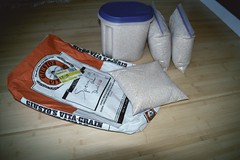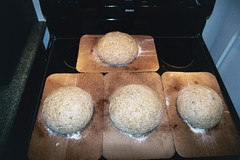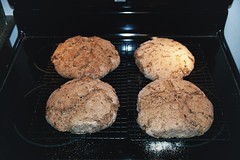I’m going to present two methods to the following recipe: one for those who’ll be using a sourdough starter, and those who’re simply interested in making scones. If you’re not using the starter, you’re still going to be OK, because using a sourdough starter doesn’t add any mass to the party – it simply means that you’re going to let your starter play around in the flour & filtered water for a bit, and then you’re going to remove the same portion as you’d added. So, using a sourdough starter results in zero added liquid or solid to the recipe (we’ll ignore the bacteria and yeast). The sourdough changes the equation very little, except in terms of time, so it’d probably be easier to do this recipe without the sourdough … but, if you’re like me, you’ve got a starter sitting in the fridge, sulking, and you use it every chance you get, because baking bread twice a week is a bit much, but that’s what keeps the starter happy.
Apricot – Orange Scones:
- Sourdough Starter
- 5 C Whole Wheat Flour
- 5 C Whole Oat Flour
- 1 C Oat Bran
- 1 tsp Salt
- 2 Tbsp Baking Powder
- 1/2 tsp Baking Soda
- 2 C Filtered Water
- 1 C Unsweetened Soy Milk
- 1/2 C Sugar
- 3 Tbsp Molasses
- 3 Tbsp Honey
- 3 Tbsp Maple Syrup (substitute Honey if you don’t use Maple, and vice versa)
- 2 Tbsp Olive Oil
- 1 tsp Vanilla Extract
- 2 tsp Almond Extract
- Zest of 1 Large Orange, Chopped
- 1 C Dehydrated Apricots, cut into ribbons
- 2 Tbsp Ginger Powder
- 2 Cardamom Pods, seeds only, ground
- 1 tsp Cloves, ground
- 1 tsp Cinnamon / Cassia, ground
- 1/4 tsp Nutmeg, ground
- 2 Tbsp Fennel Seed, whole – don’t grind
If you’re using sourdough starter, go through feeding & prepping step:
Add filtered water to sourdough starter; add wheat flour to hydrate enough so that your starter can “feed” for several hours. After starter has fed, mix in enough wheat flour to bring it to the same consistency it was when you removed it from its home; remove same quantity of starter back to its home.
Continue, or if you’re not using sourdough starter, simply start here:
Mix dry ingredients, spices, fruit, and zest in one bowl, reserving some of the flour so that you don’t end up too dry (you can always add it, you can’t ever get it back out). Mix wet together in a separate bowl (sugars count as “wet” in this game). Add the wet to the dry and fold to combine, as you would biscuits. Turn out onto a floured board, knead briefly until the dough just comes together, then roll into a sheet approximately 1 inch thick. Sprinkle tops with sugar. Cut into triangles (I use a pizza cutter, cut into squares, then run through on the diagonal), place onto an oiled baking sheet, and bake at 400°F (205°C) for approximately 12 minutes, being careful not to overbake (you can always toss them back into the oven). Remove to cooling racks … or, you know, to your awaiting plate.
Disclaimer: this recipe was something whipped up today without a “base” recipe, and, thus, quantities listed are rather approximate (except for the baking powder & soda). This works for us because we can feel our way through. I strongly encourage you to reserve quantities of flour out, or to add more flour if needed, because the addition of flour to things in our household involves tipping a 5 pound sack and stopping when it looks to be a goodly amount.
This recipe yielded about 40 scones. They lasted a day – most were given away, but there were casualties. Be warned.













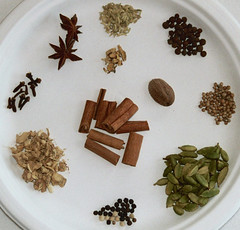
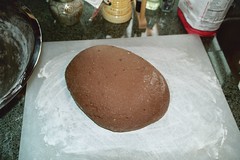

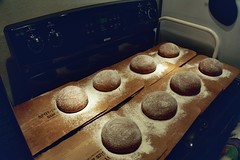
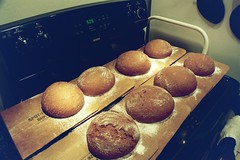
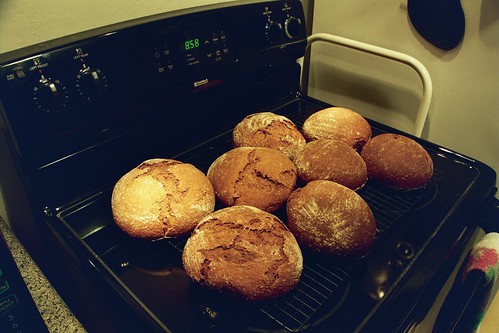
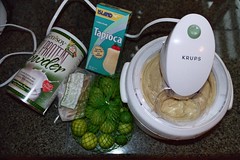
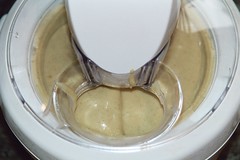
 My friend
My friend 